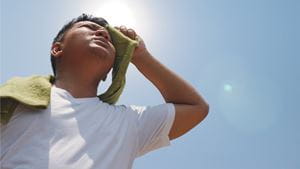
Spending more time outdoors in the summer has a variety of benefits to physical and mental health. However, there are increased risks and heat-related illnesses, including heat stroke and heat exhaustion. Severe heat-related illnesses can lead to permanent disability or death without emergency medical treatment.
Marita Michelin, MD, is the Chair of Emergency Medicine at Newark-Wayne Community Hospital and encourages everyone to know the symptoms of both heat stroke and heat exhaustion to understand when to seek medical attention.
While heat stroke and heat exhaustion are both serious medical conditions, heat stroke can be life-threatening and requires immediate medical attention. It’s important to know the differences between the sequential worsening of heat illness and what to do if you or someone you know is experiencing symptoms.
Heat exhaustion occurs when the body loses excessive amounts of water and salt, usually from sweating. Heat exhaustion is an indication that your body is overheating and, if left untreated, can lead to heat stroke.
Heat stroke is the most serious heat-related illness and occurs when the body is no longer able to regulate its internal temperature. Your body’s temperature will rise quickly, often reaching 103°F or higher. Once neurologic symptoms set in, risk of severe effects or even death can quickly rise.
“Heat stroke can lead to more serious health consequences, such as a coma. High body temperatures can also cause brain swelling, kidney failure, liver failure, nerve damage, and more,” said Dr. Michelin.
Anyone can develop heat stroke or heat exhaustion. However, certain factors may increase the risk of both conditions. According to the Centers for Disease Control (CDC), individuals are at greater risk for heat-related illness if they are:
Read more: Staying safe in the summer sun
Taking safety precautions can prevent heat stroke, heat exhaustion, and other heat-related illnesses. Dr. Michelin reminds us to take the following actions when temperatures climb.
Protect yourself. Wear lightweight clothing and sunscreen with an SPF of 30 or higher. Wearing a hat and sunglasses can also help protect your face from the heat.
Stay hydrated. Drink plenty of water and other hydrating fluids to help your body sweat and regulate temperature.
Be responsible. Never leave someone in a parked car, even if the windows are cracked or the car is in the shade. Leave parked cars locked so children cannot get inside. On hot days, be sure to limit working and exercising, and avoid physical exertion during the hottest parts of the day.
Know your risk. Be aware of the medications that you take and any underlying health conditions that may increase your risk of heat-related illness.
Heat exhaustion is considered a medical emergency when an individual is unable to cool down within 30 minutes. Heat stroke always requires immediate medical attention.
If you or someone around you is experiencing symptoms of a heat stroke or prolonged heat exhaustion, seek immediate medical help. While waiting for emergency treatment, take action to help cool the overheated person.
Read More: The difference between Urgent Care and Emergency Care
“Bring the person into shade or indoors, remove excess layers of clothing, and cool the person however you can. Find cold water to sponge or mist them, or place an ice pack or wet towel on the person’s head, neck, and armpits.”